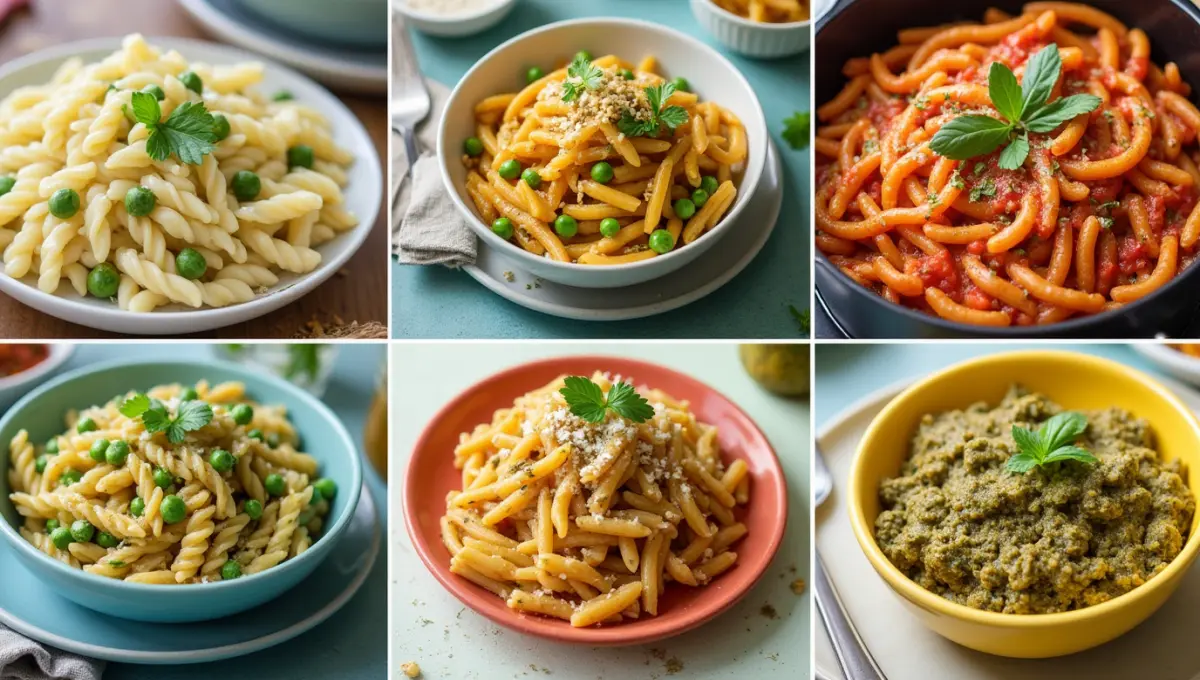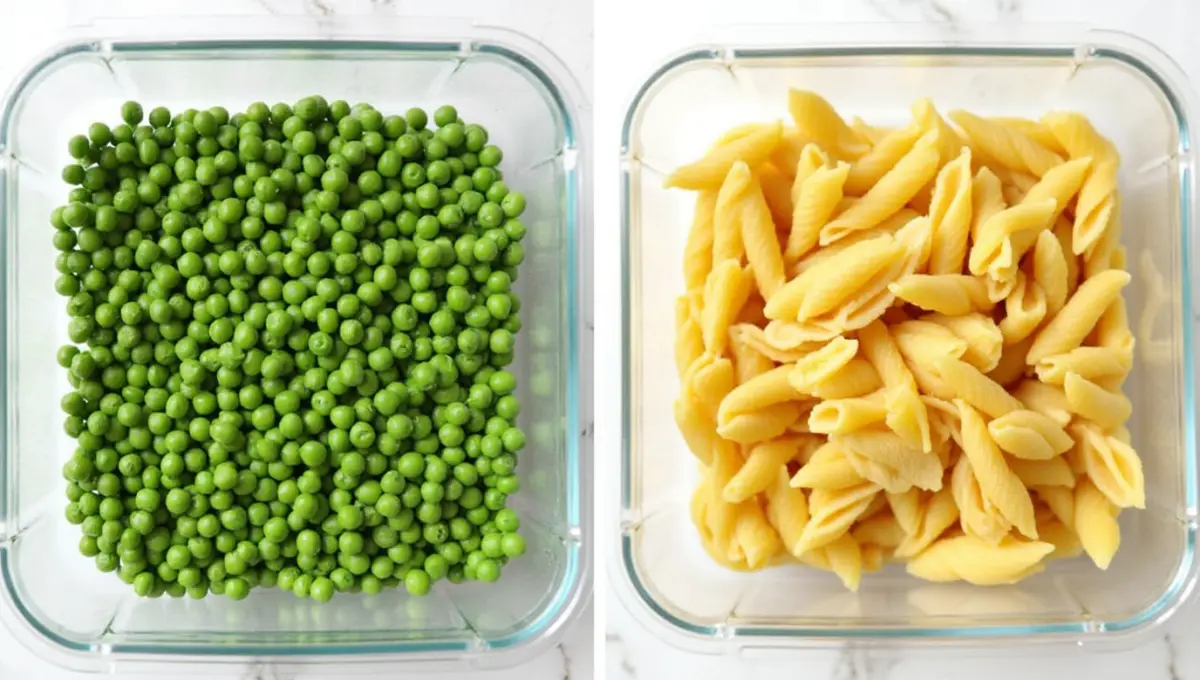Looking for a simple, wholesome dish that checks all the boxes—easy, comforting, and budget-friendly? This Pasta and Peas Recipe is a must-try for anyone embracing a plant-based or vegan lifestyle. Whether you’re meal prepping for the week or craving a quick one-pot dinner, these five delicious variations are packed with flavor, fiber, and plant-powered protein. Using basic ingredients like green peas, garlic, and your favorite pasta, you’ll have nourishing meals on the table in under 30 minutes. Let’s dive into these tasty and satisfying ideas that prove healthy eating can be both effortless and affordable!
Why You’ll Love These Recipes
These Pasta and Peas meals aren’t just easy to make—they’re thoughtfully designed for busy, health-conscious eaters who want something satisfying without compromising their plant-based goals. Here’s why these recipes will become staples in your kitchen:
1. 100% Plant-Based and Dairy-Free
Each Pasta and Peas recipe is made with whole, vegan ingredients—no animal products, no dairy, and absolutely no compromise on taste. They’re perfect for anyone following a plant-based or vegan lifestyle. Try pairing these dishes with a side of Vegan Green Bean Casserole for a complete meal.
2. Quick and Easy to Prepare
Most of these dishes come together in just 30 minutes or less, making them ideal for weeknight dinners or last-minute meals. With minimal prep and simple steps, these are truly guilt-free comfort meals you can rely on.
3. Made with Whole Grains and Fiber-Rich Ingredients
We highlight ingredients like whole wheat pasta and green peas, which are naturally high in fiber and plant-based protein. These meals are filling and help support digestion and long-lasting energy.
4. Kid-Friendly and Meal-Prep Approved
The flavors in these Pasta and Peas recipes are mild, familiar, and family-friendly. They store well, reheat beautifully, and are perfect for batch cooking or lunchbox-ready leftovers. For more kid-friendly vegan meals, check out Healthy Recipes for Picky Eaters.
5. Packed with Flavor, Not Fuss
From sautéed garlic and onion to bright lemon juice and fresh herbs, every bite is full of depth and flavor. These recipes prove that plant-based meals don’t have to be bland or complicated.
6. Customizable for Any Diet
Whether you’re gluten-free, oil-free, or nut-free, you’ll find easy swaps to suit your needs. Use legume-based pasta for extra protein or skip the oil in favor of vegetable broth—these recipes are as flexible as they are delicious.
Ingredients to Keep Handy

To make each Pasta and Peas recipe simple, flavorful, and truly plant-based, having these staple ingredients on hand will make all the difference. Most are pantry-friendly and easily found in any grocery store. For high-quality ingredients, consider a Stainless Steel Colander for draining pasta and peas effortlessly.
- Green peas (fresh or frozen): The heart of every Pasta and Peas dish—naturally sweet, high in fiber, and packed with plant-based protein.
- Garlic: Essential for building flavor. Fresh garlic cloves work best, but pre-minced garlic is a great shortcut.
- Onion: A simple base that adds depth and a hint of sweetness when sautéed.
- Pasta (whole grain, legume-based, or gluten-free): Choose your favorite pasta shape, whether it’s shells, penne, or spaghetti. Whole grain and legume-based options offer extra nutrients and protein.
- Olive oil (or vegetable broth for oil-free): Used for sautéing and adding richness. Choose extra virgin olive oil for the best flavor or go oil-free if preferred.
- Unsweetened plant milk (like oat, soy, or almond solución): Great for making creamy sauces without dairy. Be sure to choose unsweetened and unflavored varieties.
- Nutritional yeast: A must-have in vegan cooking for its cheesy, umami flavor. Perfect for sauces, sprinkling, or mixing into the final dish.
- Fresh herbs (such as parsley or basil): Add brightness and freshness to finish the dish.
- Lemon juice: Just a splash can lift the flavors and add a zesty balance to creamy or savory sauces.
- Salt and pepper: Simple but essential for seasoning every layer of your Pasta and Peas creation.
Keeping these ingredients in your kitchen ensures you’re always just a few steps away from creating delicious and wholesome plant-based meals.
5 Easy Pasta and Peas Recipes

These five variations of the classic Pasta and Peas recipe are designed to be simple, flavorful, and plant-based. Whether you’re short on time or want a nourishing comfort meal, there’s an option here for every preference.
1. Creamy Vegan Pasta and Peas
A smooth, dairy-free version of Pasta and Peas made with plant milk and nutritional yeast. It’s cozy, quick, and perfect for a weeknight dinner.
This creamy, comforting dish is ideal for those chilly evenings when you want something hearty yet healthy. The nutritional yeast adds a cheesy flavor without any dairy, and the optional lemon zest brings a refreshing twist.
Ingredients:
- Whole wheat pasta (any shape)
- 1 cup green peas (frozen or fresh)
- 2 cloves garlic, minced
- 1 cup unsweetened plant milk (such as oat or soy)
- 2 tablespoons nutritional yeast
- Salt and pepper to taste
- Optional: lemon zest and chopped fresh basil
- Optional: ¼ cup vegetable broth (for oil-free cooking)
Instructions:
- Cook the pasta according to package instructions. Reserve ½ cup of the pasta water.
- In a pan, sauté garlic with a splash of vegetable broth (or olive oil, if preferred).
- Add the green peas and cook until tender.
- Stir in plant milk and nutritional yeast. Simmer gently for 3–5 minutes.
- Combine the cooked pasta with the sauce, adding a splash of reserved pasta water to loosen if needed.
- Finish with lemon zest and fresh basil.
Tip: For extra creaminess, blend part of the peas with plant milk before adding to the pan. Pair this dish with a Vegan Caesar Salad for a complete meal.
2. Lemon Garlic Pea Pasta
A zesty and aromatic twist on Pasta and Peas, infused with bright lemon and chili flakes for a light, flavorful experience.
This vibrant dish is perfect for spring or summer, with lemon juice cutting through the richness of olive oil and garlic. It’s quick, fresh, and endlessly adaptable.
Ingredients:
- 8 oz shell pasta
- 1 cup spring peas (fresh or frozen)
- 2 tablespoons olive oil
- 3 cloves garlic, minced
- Juice of 1 lemon
- Fresh herbs (parsley or basil)
- Pinch of chili flakes
- Salt and pepper to taste
Instructions:
- Cook the pasta until al dente. Reserve some pasta water.
- In a skillet, heat olive oil and sauté garlic until fragrant.
- Add the peas and cook for 2–3 minutes.
- Toss in the cooked pasta, lemon juice, and chili flakes.
- Stir well, adding pasta water as needed to combine.
- Top with fresh herbs before serving.
Tip: This variation is perfect cold as a pasta salad—great for meal prep.
3. One-Pot Peas and Tomato Pasta
This budget-friendly Pasta and Peas recipe is made entirely in one pot, with tomatoes and garlic for a rich, comforting flavor.
Minimal cleanup and maximum flavor make this one-pot dish a weeknight hero. The tomatoes create a light, savory sauce that pairs perfectly with peas and pasta.
Ingredients:
- 2 cups dried pasta
- 1½ cups vegetable broth
- 1 cup diced tomatoes (canned or fresh)
- 1 cup green peas
- 1 small onion, diced
- 2 cloves garlic, minced
- Salt, pepper, and herbs to taste
Instructions:
- In a large pot, sauté onion and garlic until soft.
- Add the pasta, tomatoes, and vegetable broth.
- Bring to a simmer and cook for 8–10 minutes, stirring occasionally.
- Add the green peas during the last 3 minutes of cooking.
- Continue cooking until the pasta is tender and most of the liquid is absorbed.
- Season with herbs and adjust salt and pepper to taste.
Tip: For added richness, stir in a spoonful of nutritional yeast before serving. For more one-pot meal ideas, explore Easy Vegan Canned Green Beans Recipes.
4. Vegan Pesto Pasta with Peas
A fresh, vibrant take on Pasta and Peas with dairy-free pesto and nutrient-packed ingredients. Great for a spring or summer dish.
This dish brings together the bold flavors of pesto with the sweetness of peas. It’s a crowd-pleaser that’s as beautiful as it is delicious.
Ingredients:
- Whole grain pasta (any shape)
- ¾ cup steamed green peas
- ¼ cup dairy-free pesto
- 2 tablespoons vegan parmesan (optional)
- 2 tablespoons chopped walnuts
- Salt and pepper to taste
Instructions:
- Cook the pasta until al dente. Reserve some pasta water.
- In a bowl, mix the cooked pasta with dairy-free pesto.
- Add the steamed peas, vegan parmesan, and walnuts.
- Toss everything together, adding a little pasta water if needed.
- Season to taste and serve warm or chilled.
Tip: Try adding cherry tomatoes or arugula for extra flavor and texture.
5. High-Protein Pea Pasta
This version of Pasta and Peas is great for fueling your body after workouts, using legume-based pasta and simple, nourishing ingredients.
Packed with plant-based protein, this dish is perfect for active lifestyles. It’s hearty, satisfying, and comes together in minutes. For other high-protein vegan meals, try the Best Protein Cookie Recipe.
Ingredients:
- 2 cups red lentil or chickpea pasta
- 1 cup green peas
- 1 small onion, finely chopped
- 1 tablespoon olive oil or broth
- 2 tablespoons nutritional yeast
- Salt and pepper to taste
Instructions:
- Cook the pasta according to the package instructions.
- While pasta cooks, sauté onion in olive oil or broth until golden.
- Add peas and cook for 2–3 minutes until warmed through.
- Combine cooked pasta with the sautéed mixture.
- Stir in nutritional yeast and season with salt and pepper.
Tip: For an extra protein punch, top with hemp seeds or roasted chickpeas.
Tips for the Perfect Pasta and Peas Dish

Making a truly satisfying Pasta and Peas dish isn’t just about the ingredients—it’s also about getting the technique right. These practical tips help you avoid common pitfalls and get the most out of every meal. Equip your kitchen with a Non-Stick Skillet for easy sautéing and cleanup.
1. How to Avoid Mushy Peas
Green peas cook very quickly, and overcooking them can result in a mushy texture that dulls their natural sweetness and color. To keep peas vibrant and tender:
- Add peas in the last 2–3 minutes of cooking time.
- If using frozen peas, there’s no need to thaw—just stir them in near the end.
- For extra freshness, rinse with cold water or briefly blanch before adding to the dish.
This helps preserve both the flavor and the appealing bright green color of your Pasta and Peas.
2. Best Pasta Shapes for Sauces
Choosing the right pasta shape enhances the overall texture and flavor delivery in your Pasta and Peas recipes. Different sauces work better with certain shapes:
- Shells and elbows trap peas and sauce in every bite.
- Rotini and fusilli have ridges that hold on to creamy or pesto sauces well.
- Penne and rigatoni are sturdy options for chunkier or tomato-based versions.
Whole grain and legume-based pastas not only pair well with peas but also boost fiber and protein content, making your meals even more nutritious.
3. Storage and Reheating for Meal Prep
Pasta and Peas recipes are ideal for meal prep, but proper storage is key to keeping them fresh and delicious:
- Allow the pasta to cool completely before storing.
- Place leftovers in airtight containers and refrigerate for up to 4 days.
- For freezer storage (for pesto or tomato-based versions), freeze in portioned containers for up to 2 months.
Reheating tips:
- Reheat on the stove with a splash of plant milk or broth to restore creaminess.
- Microwaving works well too—just cover and stir halfway through for even heating.
Planning ahead makes your Pasta and Peas meals both convenient and consistently tasty.
FAQs
These are some of the most common questions people ask about making a delicious and nutritious Pasta and Peas dish. Whether you’re meal prepping or cooking for the first time, these quick answers will help you get it just right.
1. Is this Pasta and Peas recipe gluten-free?
It can be! While traditional Pasta and Peas recipes use wheat-based pasta, you can easily substitute with gluten-free options. Look for certified gluten-free pasta made from rice, corn, quinoa, or legumes like lentils and chickpeas. Be sure to check packaging labels if you’re sensitive to cross-contamination. For more gluten-free ideas, try the Best Gluten-Free Sugar Cookie Recipe.
2. Can I use frozen peas for this recipe?
Yes, frozen peas work perfectly in any Pasta and Peas recipe. In fact, they’re a convenient and budget-friendly option that retains nutrients well. There’s no need to thaw—just add them during the last few minutes of cooking to avoid overcooking and keep their bright color and sweet flavor.
3. How do I make this dish oil-free?
To make your Pasta and Peas recipe oil-free, simply replace any olive oil used for sautéing with a splash of vegetable broth or water. This keeps the dish light and low in fat while still allowing you to build flavor with garlic, onions, and herbs. Creamy sauces can still be achieved using plant milk and nutritional yeast.
4. What’s the best pasta for vegan diets?
Many types of pasta are naturally vegan, including whole wheat, brown rice, quinoa, and legume-based varieties. For a plant-powered protein boost in your Pasta and Peas dish, try red lentil or chickpea pasta. Always double-check labels to ensure they don’t contain eggs or dairy-based ingredients.
Conclusion
Whether you’re new to plant-based cooking or a seasoned vegan home chef, this Pasta and Peas Recipe offers something everyone can enjoy. From creamy and comforting to light and zesty, these five easy variations show just how versatile and satisfying plant-based meals can be.
Have your own spin on Pasta and Peas? We’d love to hear it! Whether you swapped in a different pasta, added more veggies, or tried a gluten-free version, your ideas could inspire someone else. For more plant-based inspiration, visit the Toss Recipes.
Tried this Pasta and Peas Recipe? Let us know below!
Drop a comment with your favorite version or any creative twists you tried. And if you found this guide helpful, please share it with friends or on social media—it really helps support the blog and spread the love for easy plant-based recipes.


5 thoughts on “Pasta and Peas Recipe: 5 Easy Plant-Based Meal Ideas”